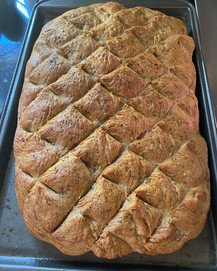Love Life ‘An Do Ya Bucket List - Calabrian Nduja
- Terry Buchanan

- Aug 4, 2020
- 4 min read
In addition to my travel bucket list, (woefully on hold due to COVID), I have a restaurant/chef bucket list that I’m ticking off constantly in the back of my mind. I have enjoyed the food at Le Bernardin, 10Arts, Perilla, Brooklyn Fare, Daniel, Topolobampo and WD-50, where the chefs have been kind enough to endure standing still for photographs with me.
One restaurant/chef on my list for some time has been April Bloomfield at The Spotted Pig in NYC. Unfortunately, I’ve put it off for too long - it is now closed, not because of COVID, but because of the misbehavior/sexual harassment charges against two of the restaurant’s owners - Ken Friedman and Mario Batali. Live and learn. Tick off the bucket list items when you can and don’t wait. I’ll settle for April’s cookbook.
One of the dishes she actually made famous (here in the U.S., it was already a staple in Italy), is Nduja (ahn-DOO-ya). Nduja is a spicy spreadable pork product from Calabria. It is traditionally made with parts of the pig such as the shoulder and belly, as well as tripe, and takes several months to make. I don’t have the time, the visceral fortitude, the patience, or frankly, the counterspace, to do that, but please enjoy this close second.
INGREDIENTS
4 ounces pancetta, raw
⅓ cup Calabrian chili peppers in oil
12 ounces Italian Salami, the gamier, the better
2 tablespoons good olive oil
¼ cup salted butter
METHOD
Add pancetta to a cold pan. Cook over medium heat, tossing occasionally, until pancetta just starts to crisp up, 4 to 5 minutes.
Remove pepper stems and, if desired, seeds. Reserve 2 or 3 tablespoons of the oil.
Separate salami pieces slightly and place in a food processor. Add the pancetta, chili oil, and Calabrian peppers. Pulse on and off until mixture is very finely ground. Add olive oil and butter. Process until as smooth and spreadable as desired.
Transfer spread to a bowl. Cover with plastic wrap and refrigerate, 8 hours to overnight, for best flavor. Heat gently to serve.
Serve this on great bread or with hard cheese or both. You can also add to pasta. I did a Roman Focaccia, started the day before:
INGREDIENTS
6¼ cups bread flour 2¼ tsp. active dry yeast
Pinch of sugar
2 Tbsp. kosher salt
5 Tbsp. extra-virgin olive oil, divided, plus more for greasing and drizzling
Flaky sea salt
METHOD
Combine flour and 2½ cups room-temperature water in your mixer’s bowl. With the dough hook, mix on low speed, scraping down sides and hook as needed to incorporate any dry flour, until a craggy kind of dough forms. Remove the bowl from the mixer and cover with plastic. Stir yeast, sugar, and ½ cup warm water together in a small bowl. Let sit until yeast is foamy, about 5 minutes.
Pour yeast mixture into stand mixer bowl and mix on low speed until dough absorbs all additional water, about 1 minute, slowly so the liquid doesn't splash all over you.
Add salt and continue to mix, increasing speed to medium, until dough is extremely elastic and very sticky (it will look more like a thick batter and will stick to sides of bowl), about 5 minutes.
Pour 3 Tbsp. oil into a large glass bowl and swirl to coat sides. Scrape in dough with a large spatula or flexible bench scraper. Cover and place in a warm spot until dough is doubled in volume, 2–3 hours. Drizzle 2 Tbsp. oil over a half sheet pan and use fingertips to rub all over bottom and sides. Using large spatula, fold dough into the bowl a couple of times to deflate, then scrape onto prepared baking sheet.
Using oiled hands, lift up dough and fold over onto itself in half, then rotate baking sheet 90° and fold in half again. Cover dough with a piece of well-oiled plastic and let rest.
Uncover and go back in with oiled hands, gently stretching dough across the length and width of the baking sheet in an even layer, working all the way to edges and into corners. If dough starts to spring back, let sit 5–10 minutes and start again. Cover again with same piece of oiled plastic and chill at least 8-24 hours.
Let sheet pan sit in a warm spot until dough is puffed and bubbly and nearly doubled in height, 45–65 minutes Meanwhile, place a rack in center of oven; preheat to 450°.
Remove plastic and drizzle dough generously with more oil. With a very sharp knife, cut a diamond patgtern in the bread, or just dimple it with your fingers all over the surface. Sprinkle generously with sea salt, and if you like, some Italian seasoning.
Bake focaccia until surface is deep golden brown all over, 25–35 minutes. Let cool in pan 10 minutes. Slide a thin spatula underneath focaccia to loosen from sheet pan and transfer to a wire rack to let cool.
Depending upon the salami you use, this dish is not only a bit spicy, it’s a bit gamey, so one of your favorite Pinot Noirs might work. But I liked it with the Bottega Oro Prosecco.
Postscript:The leftover nduja is a great base for other dishes. I mixed some with fresh chopped tomatoes and garlic, and baked some chicken thighs in it, topped with a bit of mozzarella and Parmesan Cheese. Delicioso. Now, get on that bucket list.











Comments